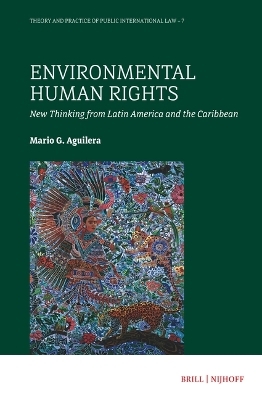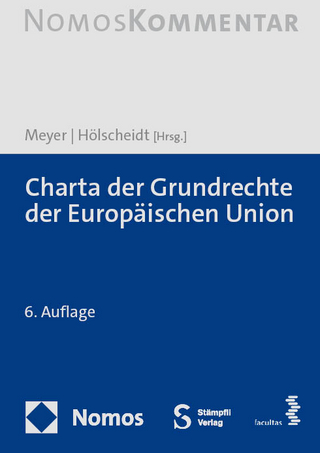
Environmental Human Rights
Martinus Nijhoff (Verlag)
978-90-04-54376-8 (ISBN)
Advancing sustainable development and democracy are the underlying purposes linking the landmark Escazú Agreement with the American Convention on Human Rights. Exploring both these treaties and the relevant regional jurisprudence, this monograph provides the first analysis of the ground-breaking environmental human rights law being developed in Latin America and the Caribbean. The key feature of the regional law is the priority it gives to equality and non-discrimination for vulnerable persons and groups, environmental defenders, local communities and indigenous peoples. This book brings practitioners and academics up to date with the legal tools for protecting people and planet.
Mario G. Aguilera, PhD (2021), University of Goettingen, is an international lawyer and a research partner at the Max Planck Institute for Social Anthropology. He has worked for the Inter-American Commission on Human Rights and has published in the field of the law of human rights and the environment.
Foreword
Preface and Acknowledgements
List of Tables and Figures
Abbreviations
Table of Cases
Table of Legislation
Introduction
Part 1
The Inter-American Human Rights System
1 The Inter-American Human Rights System in a Nutshell
1.1 Environmental Protection in Regional Human Rights Treaties
1.2 The Inter-American Commission on Human Rights
1.3 The Inter-American Court of Human Rights
1.4 Interpretation Criteria
2 Human Rights from an Environmental Perspective
2.1 Indigenous and Tribal Peoples
2.1.1 Yakye Axa v. Paraguay
2.1.2 Saramaka People v. Suriname
2.1.3 Xákmok Kásek Indigenous Community v. Paraguay
2.1.4 Kichwa Indigenous People of Sarayaku v. Ecuador
2.1.5 Kaliña and Lokono Peoples v. Suriname
2.1.6 Xucuru Indigenous People v. Brazil
2.2 Civil Society, Environmental Human Rights Defenders, and Collective Action
2.2.1 Claude Reyes v. Chile: The Right to Access Environmental Information
2.2.2 Human Rights Defenders in the Environmental Context
2.2.3 Environmental Collective Action in a Democratic Society
2.3 Concluding Observations
2.3.1 Convergence between Indigenous and Tribal Rights and Environmental Protection
2.3.1.1 Entry Point: The Right to Property
2.3.1.2 Link between Cultural Identity, Non-discrimination and Vulnerability
2.3.1.3 Territorial Rights: Tensions between Communities, Individuals, and States
2.3.1.4 Unpacking the Collective Dimension of Indigenous and Tribal Rights
2.3.1.4.1 Recognition of Collective Rights Subjects
2.3.1.4.2 Collective Rights to Public Participation and Consultation
2.3.1.5 Recognition of Collective Rights Subjects and Environmental Implications
2.3.2 Environmental Protection and Democracy: Possibilities for Individual and Collective Action
3 Recognition of the Right to a Healthy Environment and Its Implications
3.1 The Advisory Opinion oc-23/17 on the Environment and Human Rights
3.1.1 Factual Context of the Advisory Opinion oc23/17
3.1.2 Convergence of Human Rights, Environmental Protection, and Sustainable Development
3.1.2.1 Interpretation Criteria
3.1.2.2 Emergence of a Human Right to a Healthy Environment
3.1.2.2.1 Reception under Article 26 of the achr
3.1.2.2.2 Content of the Right to a Healthy Environment
3.1.2.3 Recognition of Specific Environmental Human Rights
3.1.2.4 Differentiated Treatment for Groups in Vulnerable Situations
3.1.3 Responses to the Colombian Questions
3.1.3.1 Extraterritorial Application of Environmental Human Rights Obligations
3.1.3.2 Environmental Obligations Derived from the Rights to Life and to Personal Integrity
3.1.3.2.1 Obligation of Prevention
3.1.3.2.2 Precautionary Principle
3.1.3.2.3 Obligation of Cooperation
3.1.3.2.4 Procedural Obligations
3.1.3.2.5 Specific Measures for Indigenous and Tribal Peoples
3.2 Lhaka Honhat Association (Our Land) v. Argentina
3.3 Concluding Observations
3.3.1 Innovative Features
3.3.1.1 The Right to a Healthy Environment: Inter-temporal and Non-human Dimensions
3.3.1.2 Extraterritorial Jurisdiction and Diagonal Environmental Human Rights
3.3.2 Lacunae
3.3.2.1 Specific Safeguards for Persons and Groups in Vulnerable Situations
3.3.2.2 Collective Action as a Tool for Strengthening Environmental Democracy
3.3.2.3 Business and Environmental Human Rights
3.3.2.4 Triggering Thresholds of Environmental Obligations
3.3.3 Sustainable Development: The Concept Underpinning the Relationship between Human Rights and Environmental Protection
Conclusions to Part 1: Environmental Human Rights through Interpretation of Norms
Part 2
The Escazú Agreement
4 The Escazú Agreement in Historical Perspective
4.1 The Overlapping Road to Rio +20 and to the Escazú Agreement
4.2 Preparatory Phase
4.3 Negotiation Phase
4.3.1 ‘Progressive’ and ‘Least Progressive’ Countries
4.3.2 Negotiating Machinery
4.4 Significant Participation of the Public
4.5 Concluding Observations
5 Structure of the Escazú Agreement
5.1 General Part
5.1.1 Objectives and Purposes (Preamble and Article 1)
5.1.2 Definitions (Article 2)
5.1.2.1 Access Rights
5.1.2.2 Environmental Information
5.1.2.3 Competent Authority (Public Authority, and Competent State Entities)
5.1.2.4 The Public
5.1.2.4.1 Individual and Collective Rights Subjects
5.1.2.4.2 The Nationality of the Rights Subjects
5.1.2.4.3 Rights Subjects under the Jurisdiction of the State Party
5.1.2.4.4 Rights Subjects in the Context of Transboundary Environmental Harm
5.1.2.5 Persons or Groups in Vulnerable Situations
5.1.3 Guiding Principles (Article 3)
5.1.4 General Provisions (Article 4)
5.2 The Five Pillars
5.2.1 First Pillar: Access to Environmental Information (Articles 5 and 6)
5.2.1.1 Access to Environmental Information
5.2.1.2 Generation and Dissemination of Environmental Information
5.2.2 Second Pillar: Public Participation in the Environmental Decision-Making Process (Article 7)
5.2.3 Third Pillar: Access to Justice in Environmental Matters (Article 8)
5.2.4 Fourth Pillar: Equality and Non-discrimination – Breaking Down Barriers for Persons and Groups in Vulnerable Situations
5.2.4.1 Obligations on Guidance and Assistance
5.2.4.2 Ethnic Groups, Indigenous Peoples, and Local Communities
5.2.4.3 Human Rights Defenders in Environmental Matters (Article 9)
5.2.5 Fifth Pillar: Capacity-Building and Cooperation (Articles 10–14)
5.2.5.1 National Implementation, Capacity-Building, and Resources
5.2.5.2 Cooperation
5.2.5.3 Regional Clearing-House Mechanism
5.2.5.4 The Voluntary Fund
5.3 Institutional Architecture
5.3.1 The Conference of the Parties (Articles 15 and 16)
5.3.1.1 Presiding Officers
5.3.1.2 Participation of the Public
5.3.1.3 Time and Place of Meetings
5.3.1.4 Decision-Making
5.3.1.5 Subsidiary Bodies
5.3.2 Secretariat (Article 17)
5.3.3 Committee to Support Implementation and Compliance (Article 18)
5.3.3.1 Composition and Structure
5.3.3.2 Mandate
5.3.3.3 Non-compliance Procedure
5.3.3.4 Measures
5.4 Final Clauses (Articles 19–26) and Annex 1
5.5 Concluding Observations
5.5.1 Innovative Features
5.5.1.1 The First Regional Environmental Human Rights Treaty
5.5.1.2 Capacity-Building and Cooperation to Ensure the Progressive Implementation of the ea
5.5.1.3 Establishing Environmental Human Rights for the Most Vulnerable
5.5.2 Lacunae
5.5.2.1 Lack of Definitions
5.5.2.2 Discriminatory Definition of the Public
5.5.2.3 Specific Safeguards for Indigenous and Tribal Peoples and Local Communities
5.5.2.4 Systematic and Inter-disciplinary Interpretation
Conclusions to Part 2: Environmental Human Rights through the Creation of Norms
Part 3
Stocktaking
6 Regional Environmental Human Rights Law
6.1 ‘Democracy’ and ‘Sustainable Development’: The Concepts Underpinning the Regional Environmental Human Rights Framework
6.2 Observable Complementarities
6.3 Divergences and Possible Rapprochements
6.3.1 Rights-Holders
6.3.2 Non-human Dimension of the Right to a Healthy Environment
6.3.3 Competing Jurisdictions
6.4 The Regional Environmental Human Rights Framework
6.5 The Incompleteness of Global Debates on Sustainable Development
Conclusion
Bibliography
Index
| Erscheinungsdatum | 10.07.2023 |
|---|---|
| Reihe/Serie | Theory and Practice of Public International Law ; 7 |
| Sprache | englisch |
| Maße | 155 x 235 mm |
| Gewicht | 867 g |
| Themenwelt | Recht / Steuern ► EU / Internationales Recht |
| Recht / Steuern ► Öffentliches Recht ► Völkerrecht | |
| ISBN-10 | 90-04-54376-7 / 9004543767 |
| ISBN-13 | 978-90-04-54376-8 / 9789004543768 |
| Zustand | Neuware |
| Haben Sie eine Frage zum Produkt? |
aus dem Bereich


